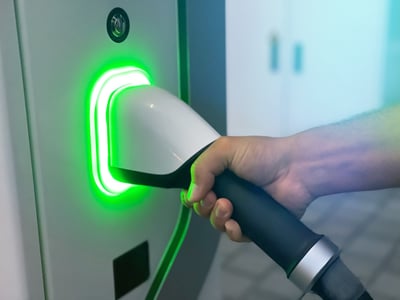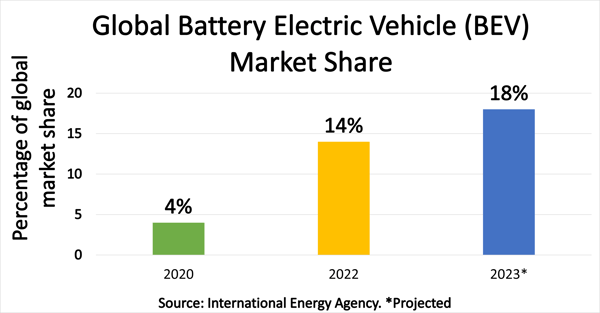Low-Conductivity Coolants for Charging Stations
We've written here about electric vehicle coolants, fuel cell coolants and electrolyzer coolants ... but what about low-conductivity coolants for charging stations?
After all, if you're driving an electric vehicle, at some point you'll need to recharge when you're out on the road. Just like the vehicle itself, the charging stations that provide the power to keep your EV going also require thermal management. 
And according to one recent report by J.D. Power, consumers have expressed dissatisfaction with the reliability of charging stations.
“Public charging continues to provide challenges to overall EV adoption and current EV owners alike,” said Brent Gruber, executive director of global automotive at J.D. Power, in the firm's report on the consumer study's findings. “Not only is the availability of public charging still an obstacle, but EV owners continue to be faced with charging station equipment that is inoperable.”
What does that mean? Charging stations will have to be more reliable to gain consumer trust and, in turn, increase uptake of electric vehicles.
- The current landscape of charging infrastructure
- The basic types of charging stations
- What happens if charging stations don't get that thermal management
- Why an effective coolant is needed to maintain a stable temperature environment within the charging apparatus
growth in the Electric vehicle market
The market share of battery electric vehicles has surged in recent years as consumers slowly begin to consider the option against the traditional internal combustion engine vehicles we've known for decades.
According to an April 2023 report from the International Energy Agency, electric cars' share of the global car market surged from just 4% in 2020 to 14% in 2022. Furthermore, the IEA projects that share to jump to 18% this year.

As demand increases, BEV drivers will need reliable access to charging stations. If you've considered purchasing an electric vehicle, maybe you've considered the hangup of a lack of charging infrastructure near you or even range capabilities of the vehicle.
Research and development continues with respect to extending the range of battery electric vehicles. Meanwhile, governmental efforts around the world, including in the U.S., have taken aim at strengthening charging infrastructure to prepare for the new age of driving and to meet long-term climate change goals.
Charging Station Availability
Electrification of Class 5-8 vehicles is also happening, too.
Buses, trucks, delivery vehicles — all of those will also need charging stations. The electrification of vehicles is a slow process, and there is much work to be done on both the vehicle/battery R&D side and the charging infrastructure side. From a consumer perspective, many want to see more affordable models and better range before they consider making a move to buy a battery electric vehicle.
According to the National Association of Convenience Stores, there are 118,678 convenience stores selling fuel in the United States. As a result, we often take availability of gas stations for granted. By contrast, according to the U.S. Department of Energy's Alternative Fuels Data Center, there were 53,492 electric charging stations in the U.S. as of 2022.
If you're driving an ICE vehicle on a road trip, for example, and are passing through some more remote parts of the country, you might need to do a little bit of quick research in the car to locate the nearest gas station if you're running low on fuel. More often than not, though, finding a gas station is a fairly stress-free endeavor. In many places, you might even find multiple gas stations at the same intersection. If you're road tripping, almost any exit you take is likely to have a gas station within a mile or two of peeling off of the highway.
Meanwhile, an electric vehicle road trip will likely require a little more planning, as this video by YouTube personality @UrAvgConsumer shows.
Types of Charging Equipment
So what are the main types of charging stations?
Simply put, they're typically broken down according to rate of charging speed.
The three basic types of electric vehicle chargers include:
- Level 1, or 120V AC outlets, i.e., residential. As the Department of Transportation notes, a Level 1 charger can take over 50 hours to charge a battery electric vehicle to 80% from empty.
- Level 2, or 240V outlets, which can also be found in public places. These take about 4-10 hours to charge to 80%, according to the DOT.
- Lastly, Direct Current Fast Charging (DCFC) stations offer the fastest charging speed. Per the DOT, these can charge to 80% in just 20-60 minutes.
In addition, each type has its own connectors, or the thing that plugs into the vehicle (as you may know, Tesla offers its own specifically designed connector for the Tesla Supercharger).
At least in practice, fueling up is not much different with an electric vehicle charging station. When you reach a charging station, you plug the charger's connector into your vehicle's charging port.
The charging station will then deliver electricity, typically charging by kWh.
Why Are Coolants for Charging Stations Important?
Like vehicles, charging stations can also overheat, leading to potential damage to components and failure of the charging system.
As such, thermal management of these systems is also required, particularly for the fastest tier of electric vehicle chargers.
Here are some ways an electric vehicle charging station can overheat:
- High ambient temperatures: Charging stations, like any electronic device, generate heat during operation. If the ambient temperature is already high, it can hinder proper heat dissipation, leading to an increased risk of overheating.
- Excessive power demand: When multiple vehicles are simultaneously charging at a high power level from the same charging station, it can put a significant load on the charging infrastructure. If the demand exceeds the capacity of the charging station or its cooling system, it can result in overheating.
- Faulty equipment or components: Defective or worn-out components within the charging station, such as faulty cooling fans, damaged power electronics, or malfunctioning thermal sensors, can cause overheating issues.
- Inadequate ventilation: Proper ventilation is crucial to dissipate heat effectively. If the charging station is located in an enclosed area or lacks adequate airflow, it can impede the cooling process, leading to overheating.
- Electrical issues: Problems with the electrical supply, such as voltage fluctuations or inadequate power conditioning, can affect the charging station's performance and potentially lead to overheating.
- Improper installation: If the charging station is not installed correctly or if the electrical connections are loose or poorly made, it can result in increased resistance and subsequently cause excessive heat generation.
- Overloading or misuse: If users attempt to draw more power from the charging station than it can handle or use incompatible charging cables or adapters, it can strain the system and cause overheating.
With proper liquid cooling — combined with other measures, like proper ventilation — you can avoid overheating of an electric vehicle charging station.
To that point, another challenge to note for electric vehicle users: out-of-service charging stations. According to a recent J.D. Power report, 20.8% of consumers indicated they had arrived at a public charger that did not work. While that doesn't necessarily mean those stations were down due to thermal management issues, it does underscore the critical need for maintenance of these power-dispensing sources.
Just like gas station pumps, electric vehicle charging stations can fall out of service for various reasons. In order for the electric vehicle market to grow and win consumer confidence, those same consumers will also need to see more charging station availability and reliability.
Summary
In short, coolants for charging stations are just as important as coolants for electric vehicles. After all, without functional charging stations, many BEV drivers might not have the access to charging capability when and where they need it. While other forms of BEV charging are being developed and rolled out — namely, mobile charging — charging stations will continue to be a central focus of BEV charging rollout
In order for uptake of battery-electric vehicles to increase, consumers want to see improvements in charging infrastructure. Circling back to the aforementioned J.D. Power report:
"A whopping 20 percent of respondents who went to a public charging station didn’t even charge their vehicle," the report states. "The reason for this—cited by 72 percent of those who didn’t charge—is that the station was somehow broken or out of service."
While a number of things can go wrong in any complex piece of machinery, like an EV charging station, one potential pitfall is ineffective or nonexistent heat dissipation.
Without it, the station can overheat and, eventually, become inoperable — making it just another data point in that "broken or out of service" statistic.
Dober has been forward-thinking in its approach to the next-generation vehicle and electrolyzer coolant market. Download our fuel cell coolant and battery electric vehicle coolant e-books to learn more.





-1.png?width=352&name=PFD%20-%20Product%20Page%20-EV%20SLC%20(2)-1.png)